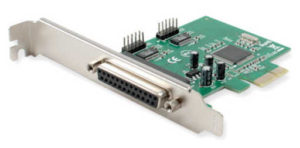 Yes, there are options to parallel port (not provided by HobbyCNC) that use USB or Ethernet. These jack-up the price considerably, though.
Yes, there are options to parallel port (not provided by HobbyCNC) that use USB or Ethernet. These jack-up the price considerably, though.
The parallel port allows for the level of direct control required for CNC. There are a couple of options. The easiest and cheapest is usually to find an inexpensive used desktop computer with a parallel port — these can often be found for $60 or less. The second option is to install an EPP compatible parallel port PCI card in your computer. These can be found for under $20 online.
Lastly, there are a couple of companies that offer USB card products with their own plugin to Mach 3 — these offload the realtime requirements from Mach to a DSP chip on the card. The are pricier than either a parallel port or a used PC, but they do offer reliable signals and faster pulse rates than a parallel port can typically offer:
Generic USB-to-Parallel converters will not work. Although the overall computing demand is low, the timing of the signals on the parallel port is CRITICAL. CAM software depends not only on the signals coming out of the parallel port, but also on the timing of those signals to control the motors. These programs are operating in an effectively “real time” environment to make sure that motions happen at the right speed from multiple axes. Generic USB converters do not maintain the timing associated with the step and direction signals, therefore they are useless for CNC.
